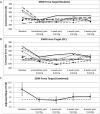High-velocity, low-amplitude spinal manipulation training of prescribed forces and thrust duration: A pilot study
- PMID: 30951380
- PMCID: PMC7682642
- DOI: 10.7899/JCE-18-19
High-velocity, low-amplitude spinal manipulation training of prescribed forces and thrust duration: A pilot study
Abstract
Objective: High-velocity, low-amplitude spinal manipulation (HVLA-SM) may generate different therapeutic effects depending on force and duration characteristics. Variability among clinicians suggests training to target specific thrust duration and force levels is necessary to standardize dosing. This pilot study assessed an HVLA-SM training program using prescribed force and thrust characteristics.
Methods: Over 4 weeks, chiropractors and students at a chiropractic college delivered thoracic region HVLA-SM to a prone mannequin in six training sessions, each 30 minutes in duration. Force plates embedded in a treatment table were used to measure force over time. Training goals were 350 and 550 Newtons (N) for peak force and ≤150 ms for thrust duration. Verbal and visual feedback was provided after each training thrust. Assessments included 10 consecutive thrusts for each force target without feedback. Mixed-model regression was used to analyze assessments measured before, immediately following, and 1, 4, and 8 weeks after training.
Results: Error from peak force target, expressed as adjusted mean constant error (standard deviation), went from 107 N (127) at baseline, to 0.2 N (41) immediately after training, and 32 N (53) 8 weeks after training for the 350 N target, and 63 N (148), -6 N (58), and 9 N (87) for the 550 N target. Student median values met thrust duration target, but doctors' were >150 ms immediately after training.
Conclusion: After participation in an HVLA-SM training program, participants more accurately delivered two prescribed peak forces, but accuracy decreased 1 week afterwards. Future HVLA-SM training research should include follow-up of 1 week or more to assess skill retention.
Keywords: Formative Feedback; Manipulation, Chiropractic; Motor Skills; Task Performance and Analysis.
© 2020 Association of Chiropractic Colleges.
Conflict of interest statement
Supported by the Palmer Center for Chiropractic Research, Palmer College of Chiropractic, and by grants from Kiernan Family Trust (ZKS and RDV), from United States Defense Health Program Clinical Trial Award (RDV), from the National Institutes of Health, National Center for Complementary and Integrative Health (RDV), from other donations for research not related to the current work (MRG), and other travel reimbursements by Cox Certification seminars (MRG).
Figures


References
-
- Descarreaux M, Dugas C. Learning spinal manipulation skills: assessment of biomechanical parameters in a 5-year longitudinal study. J Manipulative Physiol Ther. 2010;33(3):226–230. - PubMed
-
- Triano JJ, Descarreaux M, Dugas C. Biomechanics–review of approaches for performance training in spinal manipulation. J Electromyogr Kinesiol Off J Int Soc Electrophysiol Kinesiol. 2012;22(5):732–739. - PubMed
LinkOut - more resources
Full Text Sources
Miscellaneous
